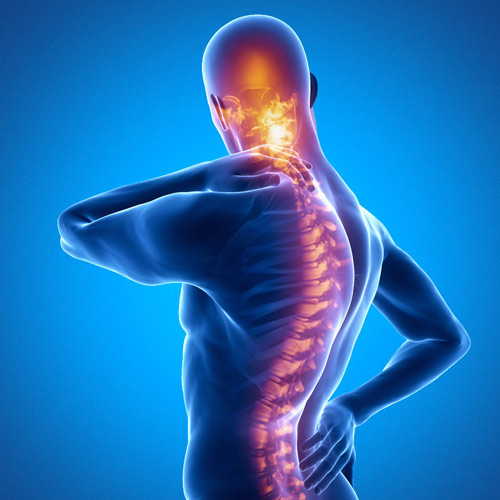Ankylosing Spondylitis
ANKYLOSING SPONDYLITIS (AS) is a form of chronic inflammation of the spine and the sacroiliac joints. Chronic inflammation in these areas causes pain and stiffness in and around the spine. Over time, chronic spinal inflammation can lead to a complete cementing together (fusion) of the vertebrae, a process referred to as ankylosis. Ankylosis leads to loss of mobility of the spine and the condition known as bamboo spine.
Ankylosing spondylitis is also a systemic disease which can affect other tissues, throughout the body. Accordingly, it can cause inflammation or injury to other joints away from the spine, as well as to other organs, such as the eyes, heart, lungs, and kidneys. Ankylosing spondylitis shares “many features with several other arthritis conditions such as psoriatio arthritis, reactive arthritis (formerly called Reiter’s disease); and arthritis associated with Crohn's disease and ulcerative colitis.
It is important to note that the course of Ankylosing spondylitis varies greatly from person to person. So too can the onset of symptoms. The most common age of onset of symptoms is in the second and third decades of life.

SIGNS AND SYMPTOMS
The symptoms of Ankylosing spondylitis are related to inflammation of the spine, joints, and other organs. Fatigue is a common symptom associated with active inflammation. Inflammation of the spine causes pain and stiffness in the low back, upper buttock area. neck, and the remainder of the spine. The onset of pain and stiffness is usually gradual and progressively worsens with loss of range of motion noticeable over months. Occasionally, the onset is rapid and intense.
Chronic spondylitis and ankylosis cause forward Curvature of the upper torso (thoracic spine), which limits breathing capacity. Spondylitis can also affect the areas where ribs attach to the upper spine, further limiting lung capacity. Ankylosing spondylitis can cause inflammation and scarring of the lungs, causing coughing and shortness of breath, especially with exercise and infections. Therefore, breathing difficulty can be a serious complication of Ankylosing spondylitis.
DIAGNOSIS
There is no direct test to diagnose -AS. A clinical examination, MRI and X-ray studies of the spine, which ' show characteristic spinal changes and sacroiliitis, and a simple genetic marker blood test 'are the major diagnostic tools. A drawback of X-ray diagnosis is the signs ' and symptoms of AS have usually been established as long as 8-10 years prior to X-ray-evident changes occurring on a plain film X-ray, which means a delay of as long as 10 years before adequate therapies can be introduced. Options for earlier diagnosis are tomography and magnetic resonance imaging of the sacroiliac joints, but the reliability of these tests is still unclear.
AYURVEDA MANAGEMENT
Ayurveda offers excellent therapies for treating Ankylosing spondylitis. The strength of Ayurveda in the area of spine and joint treatments is globally appreciated. Since it addresses the root cause of the issue, the results are fantastic.
Ayurveda has in-depth knowledge of causative factors of AS and clearly explained the pathogenesis and line of treatment to be followed.
At SRI AAYUSH, with our deep understanding and research, we are providing a very effective treatment methodology based on the classical texts of Ayurveda. Treatment is usually aggressive, long-term and requires regular and careful follow-ups. The treatment comprises of a series of purification procedures for Detoxification through world renowned Ayurveda Panchakarma therapies along with the administration of researched medicines internally.
Panchakarma procedure requires around 60 to 90 days based on the severity & chronicity of the disease. Strict diet restrictions along life style modification are essential parts of the therapy. Following the diet as advised not only helps in recovering fast but also in prevents further worsening of the condition. If patient can come for the treatment in early stages even total cure is also possible.




